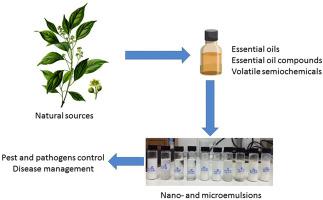Advances in Colloid and Interface Science ( IF 15.9 ) Pub Date : 2020-11-25 , DOI: 10.1016/j.cis.2020.102330 Alejandro Lucia 1 , Eduardo Guzmán 2

|
Most of the traditional strategies used for facing the management of insect pest and diseases have started to fail due to different toxicological issues such as the resistance of target organism and the impact on environment and human health. This has made mandatory to seek new effective strategies, which minimize the risks and hazards without compromising the effectiveness of the products. The use of essential oils, their components and semiochemicals (pheromones and allelochemicals) has become a promising safe and eco-sustainable alternative for controlling insect pest and pathogens. However, the practical applications of this type of molecules remain rather limited because their high volatility, poor solubility in water and low chemical stability. Therefore, it is required to design strategies enabling their use without any alteration of their biological and chemical properties. Oil-in-water nano/microemulsions are currently considered as promising tools for taking advantage of the bioactivity of essential oils and their components against insects and other pathogens. Furthermore, these colloidal systems also allows the encapsulation and controlled release of semiochemicals, which enables their use in traps for monitoring, trapping or mating disruption of insects, and in push-pull strategies for their behavioral manipulation. This has been possible because the use of nano/microemulsions allows combining the protection provided by the hydrophobic environment created within the droplets with the enhanced dispersion of the molecules in an aqueous environment, which favors the handling of the bioactive molecules, and limits their degradation, without any detrimental effect over their biological activity. This review analyzes some of the most recent advances on the use of emulsion-like dispersions as a tool for controlling insect pest and pathogens. It is worth noting that even though the current physico-chemical knowledge about these systems is relatively poor, a deeper study of the physico-chemical aspects of nanoemulsions/microemulsions containing essential oils, their components or semiochemicals, may help for developing most effective formulations, enabling the generalization of their use.
中文翻译:

含有精油、它们的成分或挥发性化学信息素的乳液作为昆虫害虫和病原体管理的有前途的工具
由于目标生物的抗药性以及对环境和人类健康的影响等不同的毒理学问题,大多数用于应对病虫害管理的传统策略已经开始失败。这使得必须寻求新的有效策略,在不影响产品有效性的情况下最大限度地减少风险和危害。使用精油、它们的成分和化学信息素(信息素和化感素)已成为控制害虫和病原体的一种有前途的安全和生态可持续的替代方法。然而,这类分子的实际应用仍然相当有限,因为它们具有高挥发性、水溶性差和化学稳定性低的特点。所以,需要设计能够在不改变其生物和化学特性的情况下使用它们的策略。水包油纳米/微乳液目前被认为是利用精油及其成分对抗昆虫和其他病原体的生物活性的有前途的工具。此外,这些胶体系统还允许信息化合物的封装和受控释放,这使得它们能够用于监测、诱捕或破坏昆虫交配的陷阱,以及用于其行为操纵的推拉策略。这是可能的,因为纳米/微乳液的使用允许将液滴内产生的疏水环境提供的保护与分子在水性环境中的增强分散相结合,这有利于生物活性分子的处理,并限制其降解,而不会对其生物活性产生任何不利影响。本综述分析了使用乳液状分散体作为控制害虫和病原体的工具的一些最新进展。值得注意的是,尽管目前对这些系统的物理化学知识相对较少,但对含有精油、其成分或化学信息素的纳米乳液/微乳液的物理化学方面进行更深入的研究,可能有助于开发最有效的配方,能够推广它们的使用。本综述分析了使用乳液状分散体作为控制害虫和病原体的工具的一些最新进展。值得注意的是,尽管目前对这些系统的物理化学知识相对较少,但对含有精油、其成分或化学信息素的纳米乳液/微乳液的物理化学方面进行更深入的研究,可能有助于开发最有效的配方,能够推广它们的使用。本综述分析了使用乳液状分散体作为控制害虫和病原体的工具的一些最新进展。值得注意的是,尽管目前对这些系统的物理化学知识相对贫乏,但对含有精油、其成分或化学信息素的纳米乳剂/微乳剂的物理化学方面进行更深入的研究,可能有助于开发最有效的制剂,能够推广它们的使用。











































 京公网安备 11010802027423号
京公网安备 11010802027423号